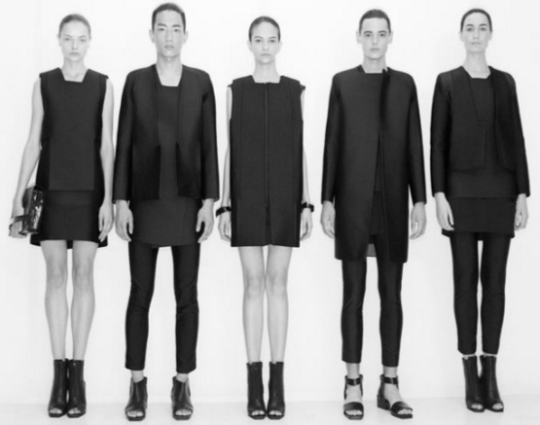
Gender-neutral merchandise is becoming more prevalent
throughout retail as companies seek to remove labels that may influence who is
purchasing specific products. While Target and Toys ‘R’ Us are taking steps to
move away from gender-based
labeling, apparel brands such as Zara have recently introduced
gender-neutral clothing to their offerings.
While apparel has typically been a category split between
genders, more
fashion shows are putting gender-neutral clothing front-and-center, potentially
serving as a preview to what shoppers can expect out of retailers in the
future.
The RTP team discusses whether
gender-neutral clothing can catch on within retail, and whether merchants would
benefit from introducing ungendered brand items from a business standpoint.
Debbie Hauss,
Editor-in-Chief: Ungendered products certainly will resonate with a
significant portion of the consumer population today. It’s hard to predict how
relevant it will be 10 years from now, though, so retailers may want to tread a
bit lightly when it comes to taking a stance on the trend from a product or
marketing point of view. Other retailers may want to take note of Zara’s
approach of “quietly” introducing its brand called
“Ungendered.” This trend also may be more relevant for more global
brands that are looking for appeal beyond the boundaries of the U.S. Generally,
I think a low-key approach will work for larger brands that want to maintain an
appeal to all segments of the population. Some smaller, niche brands may be
able to take a more aggressive approach in order to cultivate their brand among
certain segments of the population.
Adam Blair, Executive
Editor: This would certainly seem to be an opportune moment for clever
retailers to gain attention (perhaps by courting a bit of controversy) with an
expanded range of gender-neutral offerings. Led, for better or for worse, by
Caitlyn Jenner, the trans community is raising its profile, though not without
backlash: the passage of so-called “bathroom bills” that have
restricted LGBTQ people’s rights in Houston, North Carolina and elsewhere. It
almost goes without saying that retailers will need to tread carefully in this
potential minefield of identity, gender and sexuality. Also, gender-neutral or ungendered definitely lack marketing zing, both as words and as
concepts: to me they signify the absence of something rather than a creative
crossing or blurring of traditional lines. I think Selfridges was on the right
track with its Agender pop-up. How about gender-free?
Or gender by choice?
Alicia Fiorletta,
Content Strategist: I read a really interesting article on the gender-neutral apparel trend from, surprisingly, United
Hemispheres Magazine. What intrigued me the most about the piece was
the role that Millennials and Gen Zers are playing in accelerating the trend.
As teens and young adults become more sexually aware, and concepts like fluid
sexuality generate awareness and acceptance, it seems like these young
consumers are more eager to hop on the gender-neutral bandwagon. However, I
think it’s still difficult to determine whether this will remain a consistent
trend in the apparel market, or if the trend bubble will burst.
David DeZuzio,
Managing Editor: Retailers can definitely cash in on the ungendered trend
although it’s really nothing new. In reality, retailers have been providing
genderbending and unisex clothing on and off for 40+ years; see the
early-to-mid 1970s where Mick Jagger, David Bowie, Freddie Mercury and others
were pushing fashion (and other) boundaries of gender; the early 1980s New
Romantic scene where fashion was dictated by Adam Ant and others. Now we have
the ungendered offerings found in Zara and BloFish. I didn’t see anything
outrageous enough to shock anyone with these two brands. Design-wise they are not unlike the
early-to-mid ‘90s grunge movement in which both men and women were covered in
ripped jeans, flannel shirts and wore Dr. Martens boots. Boring, but they get
the job done. Alessandro Michele’s first menswear collection at Gucci, however,
would require a greater leap from one’s confidence. Overall I think like all
trends, it will be a moneymaker.
Klaudia Tirico,
Associate Editor: Ungendered clothing may seem like a fad now, but I think
it has the potential to grow into a normal retail offering in the future. If
retailers dabble in the trend even for a season or two, I think they’ll be able
to gain some valuable customer insight based on their responses. While Zara’s
approach was pretty low key, the retailer still generated some negative
feedback from the public. Customers took to Twitter to share their concerns of
the Ungendered offerings of boxy sweatshirts and jeans being too basic and
obvious. Based on the responses, Zara was able to realize that their customers
approve of unisex wardrobes but would prefer less generic offerings, including
skirts for men, a trend made popular by high fashion influencers and, I hate to
say it, Kanye West. As someone who is known to raid her husband’s closet and
shop in the men’s section of stores, I definitely think there is a market for
ungendered or unisex clothing. For retailers, it all depends on knowing your
customer base, because this style is certainly not for everyone.
Glenn Taylor,
Associate Editor: You never really know which direction fashion trends are going
to turn down the line, so making predictions about the future of an apparel
type can often be fruitless. With that said, the gender-neutral trend is picking up enough steam that it could go over extremely well with niche audiences. As any trend goes, as long as there’s a certain subsection of people buying the clothing, it will have a place in the industry. It’s not like the apparel being showcased on runways are the same items being promoted to a mass audience, so I imagine retailers will attempt to use the gender-neutral branding to promote clothes that are more accessible to a wider consumer base.






